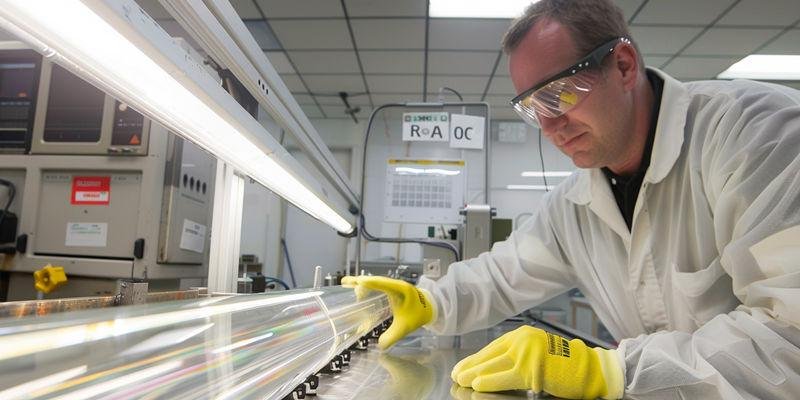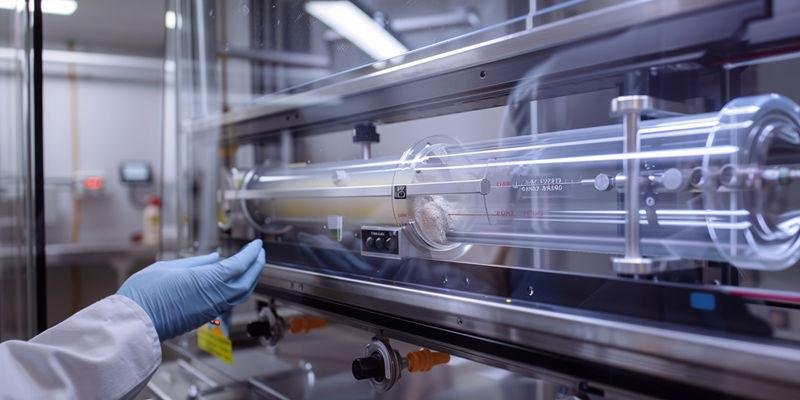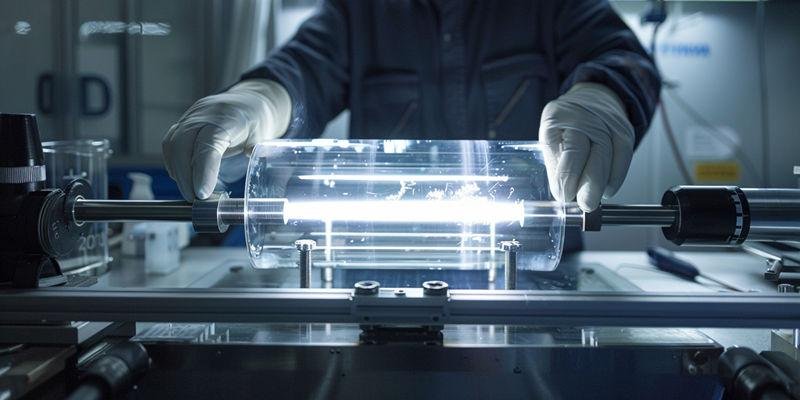
Several factors directly affect quartz tube cutting precision. The cutting process determines the achievable tolerances, edge finish, and risk of microcracks. Tube properties like wall thickness, diameter, and internal stress influence the stability of the cutting process and the final result. The cutting process also depends on fixturing and setup, which must secure the tube without causing damage. Post-cut processing, including fire-polishing and cleaning, refines the cutting process outcome. Clear specification of requirements ensures the cutting process meets end-use standards. Each stage of the cutting process plays a critical role in achieving the desired results.
Önemli Çıkarımlar
Choose the right cutting method to achieve desired precision and edge quality. CNC diamond sawing and laser cutting offer unique advantages for different applications.
Understand how tube properties like wall thickness and diameter impact cutting stability. Adjust feed rates and clamping methods based on these factors to improve results.
Ensure proper fixturing and setup to maintain dimensional stability during cutting. Use calibrated sensors to control clamping pressure and prevent tube damage.
Implement post-cut processing techniques like fire-polishing to enhance edge quality. This step is crucial for restoring strength and ensuring compliance with specifications.
Clearly specify cutting requirements with detailed technical drawings. This practice helps prevent errors and ensures the final product meets quality standards.
What Cutting Methods Achieve Different Precision Levels?
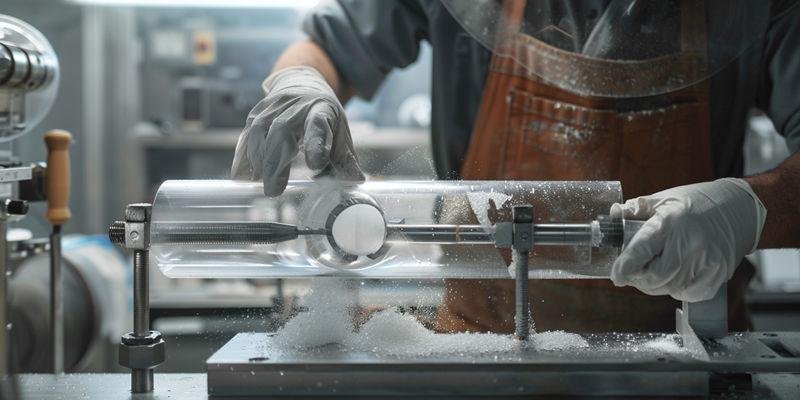
Quartz tube cutting precision depends on the selected cutting method, the equipment used, and the process parameters. Each technique offers unique advantages for dimensional accuracy, edge quality, and suitability for specific tube properties. Understanding these differences helps users choose the best method for their application.
CNC Diamond Sawing - Precision Capabilities
CNC diamond sawing delivers high precision for quartz tube cutting precision. Operators use diamond-impregnated blades with thicknesses between 0.5 and 1.0 mm, optimizing cutting speed to 5-15 mm/min for best results. This method achieves length tolerances of ±0.5 mm and perpendicularity within 0.15 mm per 100 mm diameter, meeting ISO 12123 standards for optical components.
The diamond blade’s hardness allows it to cut fused quartz cleanly, minimizing microcracks and edge chipping. CNC control ensures consistent cutting speed and blade feed, reducing human error and improving repeatability. Water-based coolant flows at 2-5 L/min, keeping the cutting temperature below 80°C and preventing thermal expansion errors that could affect quartz tube cutting precision.
CNC diamond sawing remains the preferred choice for applications requiring high precision and consistent edge quality.
Önemli Noktalar:
Unparalleled precision with diamond blades
Consistent cutting speed and coolant flow
Meets ISO 12123 standards for dimensional accuracy
This method provides reliable results for demanding quartz tube cutting precision needs.
Laser Cutting - Thermal Effects on Edge Quality
Laser cutting machine technology offers high precision for quartz tube cutting precision, especially with CO₂ and fiber laser cutting machine systems. The process uses focused laser beams to melt and vaporize quartz, achieving length tolerances of ±0.3 mm and kerf widths of 0.2-0.4 mm. Operators set cutting speed between 5 and 10 mm/s, adjusting power from 100 to 300 W for different tube diameters.
Thermal effects from the laser cutting machine can impact edge quality. Concentrated heat may cause slag and burrs, warping, discoloration, and delamination, which can reduce the smoothness and accuracy of cuts. Picosecond fiber laser cutting machine systems minimize these effects, producing edge roughness values below 1 μm and low microcrack rates, while standard laser cutting machine setups may require post-cut fire-polishing or grinding to restore edge quality.
The table below summarizes the thermal effects and their impact on quartz tube cutting precision:
Thermal Effect | Açıklama | Impact on Precision |
|---|---|---|
Slag and Burrs | Molten material redeposits due to concentrated heat | Hinders smoothness and accuracy of cuts |
Warping or Oil Canning | Edge deformation from heat, causing non-flat surfaces | Reduces precision of cut edges |
Discoloration | Color change at cut edge, indicating possible heat damage | May affect aesthetic quality and indicate warping |
Delamination | Separation of layers in laminated materials from excessive heat | Compromises structural integrity and precision |
Laser cutting machine systems provide high precision, but users must consider thermal effects and post-processing needs for optimal quartz tube cutting precision.
Waterjet and Alternative Cutting Methods
Waterjet cutting offers high precision for quartz tube cutting precision by using a narrow stream of water mixed with abrasive particles. Operators achieve cutting speed of 8-15 minutes for a 50 mm diameter tube, with edge quality superior to most other methods. The process produces minimal thermal stress, reducing microcrack formation and edge chipping.
When cutting brittle materials like quartz, edge chipping can occur. Using a backing or sacrificial material enhances rigidity and maintains a clean cut, preventing the jetstream from directly affecting the workpiece. Waterjet cutting achieves kerf widths of about 1 mm, and while taper can affect overall precision, the process results in high dimensional accuracy and often requires no secondary finishing.
Önemli Noktalar:
High precision and superior edge quality
Minimal thermal stress and reduced microcracks
Backing material helps prevent edge chipping
Waterjet cutting stands out for quartz tube cutting precision, especially when thermal effects must be minimized.
How Do Tube Properties Influence Cutting Accuracy?

Quartz tube properties play a major role in determining cutting quality and precision. Wall thickness, diameter, and internal stress each affect how the tube responds during cutting and the final edge condition. Understanding these factors helps manufacturers achieve consistent results and minimize breakage.
Wall Thickness Impact on Cutting Stability
Wall thickness directly influences cutting quality by affecting tube stability during processing. Thin-walled tubes often vibrate more, which can lead to uneven cuts and increased risk of breakage. Operators must adjust feed rates and clamping pressure to maintain cutting quality and prevent tube movement.
Thick-walled tubes provide greater resistance to vibration, allowing for more stable cutting quality. However, thicker walls require slower feed rates to avoid overheating and blade wear, which can impact production speed. According to ASTM C693, tubes with walls over 5 mm need careful monitoring to maintain cutting quality and avoid dimensional errors. Data from TOQUARTZ shows that thin-walled tubes (<2 mm) experience up to 0.5 mm deviation in perpendicularity, while thick-walled tubes (>5 mm) maintain better cutting quality but require more time for each cut.
Manufacturers can optimize cutting quality by selecting appropriate feed rates and clamping methods based on wall thickness.
Önemli Noktalar:
Thin walls increase vibration and risk of breakage
Thick walls require slower feed rates for cutting quality
Proper setup improves cutting quality and reduces breakage
Diameter-Related Geometric Challenges
Tube diameter creates geometric challenges that affect cutting quality and precision. Small diameter tubes need specialized fixturing to prevent rotation and movement, which can cause non-perpendicular cuts and breakage. Large diameter tubes require higher power and slower traverse speeds, increasing the risk of deformation and ovality.
The risk of ovality and deformation rises as tube diameter changes. The table below summarizes how diameter influences deformation and cutting quality:
Evidence Description | Impact on Tube Diameter and Deformation |
|---|---|
Smaller bending radius leads to greater deformation of the pipe cross-section. | Tube diameter affects the extent of deformation during cutting quality processes. |
Ovalization represents the maximum permissible deviation from the circular shape of the original pipe diameter. | Tube diameter is critical in determining the risk of ovality and cutting quality. |
Ovalization leads to a change in the diameter of the tube. | Tube diameter is directly influenced by the deformation process, affecting cutting quality. |
Ovality is measured by comparing maximum and minimum diameters after processing. | This provides a quantitative measure of how tube diameter is affected by deformation and cutting quality. |
Manufacturers must monitor tube diameter and adjust fixturing and cutting parameters to maintain cutting quality and minimize breakage.
Internal Stress Effects on Edge Quality
Internal stress in kuvars tüpler can significantly impact cutting quality and edge condition. Tubes with high internal stress are more likely to develop microcracks and breakage during cutting, reducing overall cutting quality. Operators use flame treatment, HF acid application, and annealing furnaces to relieve internal stress before precision cutting.
Precise control of microgroove fabrication helps mitigate crack propagation and improve cutting quality. When stress is not properly managed, laser scribing can lead to micro-cracks and burrs, which lower edge quality and increase the risk of breakage. Controlled annealing between transition and strain point temperatures eliminates permanent stress, resulting in smoother severing surfaces and better cutting quality.
Manufacturers can enhance cutting quality by measuring and mitigating internal stress before cutting.
Önemli Noktalar:
High internal stress increases microcracks and breakage
Annealing and flame treatment improve cutting quality
Controlled stress relief leads to smoother edges and better cutting quality
What Fixturing and Setup Parameters Optimize Cutting Precision?
Proper fixturing and setup play a vital role in achieving precise cuts and reducing errors during quartz tube processing. The right fixture design, clamping pressure, and alignment methods ensure dimensional stability and consistent results. By following best practices for maintenance, manufacturers can improve quartz tube maintenance and extend the life of both equipment and tubes.
Fixture Design for Dimensional Stability
Fixture design directly affects dimensional stability during cutting. A well-designed fixture holds the quartz tube securely, preventing movement and vibration that can cause inaccuracies. The use of V-blocks or two-point supports helps maintain the tube’s position and reduces the risk of deformation.
Engineers often select fixture features based on the tube’s size and wall thickness. For example, adjustable V-blocks with soft inserts distribute clamping force evenly, minimizing stress on the tube. Data shows that improved clamping design can reduce process time from 35 to 25 minutes, while uniform wall thickness and axial clamping force help maintain shape. The table below highlights how fixture design features impact dimensional stability:
Tasarım Özelliği | Impact on Dimensional Stability |
|---|---|
Clamping Force | Excessive force can deform the tube |
Use of Two Tops | Increases stability, reduces deformation risk |
Axial Clamping Force | Prevents added deformation |
Improved Clamping Design | Allows faster cutting, eliminates deformation concerns |
Heat Absorption from Cutting | Can cause stress release and deformation |
Manufacturers who focus on fixture design and regular maintenance achieve better quartz tube maintenance and more consistent cutting results.
Clamping Pressure Optimization
Clamping pressure must be carefully controlled to avoid damaging the quartz tube. Too much pressure can cause cracks or deformation, while too little allows the tube to shift during cutting. Operators use calibrated sensors to set pressure ranges between 0.2-0.4 MPa for thin-walled tubes and 0.4-0.8 MPa for thicker tubes.
Regular maintenance of clamping systems ensures that pressure remains within safe limits. Technicians inspect fixtures for wear and recalibrate sensors as part of quartz tube maintenance routines. When maintenance is neglected, even minor shifts can disrupt the machining process and lead to inconsistent dimensions.
Inaccurate workpiece holding or fixturing can lead to slight shifts during cutting, which results in inconsistent dimensions. Even minor shifts can disrupt the entire machining process.
Önemli Noktalar:
Proper clamping pressure prevents tube damage
Routine maintenance supports consistent results
Calibrated sensors help maintain safe pressure ranges
By prioritizing maintenance and best practices for longevity, manufacturers can optimize clamping and improve quartz tube maintenance.
Tool Setup and Alignment Verification
Tool setup and alignment verification are essential for maintaining cutting precision. Operators use dial indicators and laser alignment tools to check that the tube is perpendicular to the cutting blade. This step ensures that the cut remains straight and within specified tolerances.
Automated CNC routines further enhance alignment accuracy. Data from over 8,500 cutting operations shows that automated alignment reduces setup-related errors from ±0.8 mm to ±0.3 mm, increasing first-pass yield from 87% to 96%. Regular maintenance of alignment tools and equipment is a key part of quartz tube maintenance, helping to prevent drift and ensure reliable performance.
Alignment Practice | Effect on Cutting Precision |
|---|---|
Manual Setup | Higher risk of dimensional errors |
Automated CNC Alignment | Reduces errors, improves yield |
Regular Tool Maintenance | Ensures ongoing accuracy and reliability |
Consistent tool setup, alignment checks, and ongoing maintenance form the foundation of precise quartz tube maintenance and support best practices for longevity.
What Post-Cut Processing Ensures Specification Compliance?
Post-cut processing ensures that quartz tubes meet strict dimensional and surface quality standards. Each step, from fire-polishing to edge finishing and final inspection, plays a vital role in achieving compliance. Proper cleaning and verification methods help maintain long-term performance and reliability.
Fire-Polishing Process Parameters
Fire-polishing removes microcracks and smooths cut edges, restoring the tube’s strength. Operators control polishing speed, slurry composition, and pH to achieve a defect-free finish. A polishing speed of 100 rpm can reduce surface roughness from 120 ± 10 nm to 2.3 nm in 14 minutes.
Careful selection of slurry and pH levels further improves results. Using a slurry with 8 wt% SiO2 at pH 8 achieves a material removal rate of 121.6 nm/min, while 6 wt% CeO2 reduces surface roughness to 2.1 nm in 12 minutes with a removal rate of 126.2 nm/min. These parameters ensure the edge is both smooth and strong, minimizing the risk of future cracks or failures.
Önemli Noktalar:
Polishing speed, slurry composition, and pH are critical
Proper parameters yield smooth, defect-free edges
Fire-polishing restores edge strength and durability
This process prepares the tube for further finishing or immediate use, depending on application needs.
Optical-Grade Edge Finishing Techniques
Optical-grade edge finishing creates ultra-smooth surfaces for demanding applications. Techniques such as bowl feed polishing, bonnet polishing, and slurry jet polishing can achieve roughness values as low as 0.3 nm RMS. Magnetorheological finishing and reactive plasma polishing offer additional options for micro and nano-level control.
Low surface roughness is essential for thin quartz wafers, especially in semiconductor and optical uses. Precision grinding, polishing, and chemical-mechanical planarization (CMP) help achieve Ra values below 1 nm. These methods ensure minimal light scattering and high transmission, which is critical for optical performance.
Teknik | Effect on Surface Quality |
|---|---|
Bowl Feed Polishing | Achieves ultra-smooth surfaces (0.3 nm RMS) |
Bonnet Polishing | Produces up to 80 nm roughness |
Slurry Jet Polishing | Used for finer surfaces |
Magnetorheological Finishing | Enables micro/nano-level control |
Reactive Plasma Polishing | Non-contact, ultra-smooth finish |
These finishing techniques ensure the tube meets the highest standards for optical clarity and durability.
Dimensional Verification and Quality Control
Dimensional verification and quality control confirm that each tube meets specifications. Quality inspection includes checking dimensional accuracy, transparency, and hardness. Precision machining ensures the tube matches required standards for its intended use.
Quartz tube cleaning is a crucial step before final inspection. Operators clean the exterior with a mild muriatic acid solution (4:1 water to acid), rinse with water, and dry with a soft towel. The inside must be dry before installation, as cleaning frequency depends on usage. The safest way to clean narrow quartz tubes involves gentle rinsing and drying to avoid damage.
Yöntem | Açıklama |
|---|---|
Kalite Denetimi | Tests dimensional accuracy, transparency, and hardness |
Hassas İşleme | Ensures precise dimensions and compliance with standards |
Quartz Tube Cleaning | Removes contaminants, improves inspection accuracy, and supports long-term use |
Regular cleaning prevents UV transmission loss and helps identify cracks or seal issues, supporting long-term reliability and performance.
How to Specify Cutting Requirements for Optimal Results?
Specifying cutting requirements for quartz tubes ensures that the final product meets both functional and quality standards. Clear technical drawings and well-defined tolerances help manufacturers deliver consistent results. Understanding cost-performance trade-offs allows users to make informed decisions for their projects.
Technical Drawing Specifications for Custom Cutting
Technical drawings provide the foundation for accurate quartz tube customization. Designers specify tolerances, perpendicularity, and edge finish to guide the cutting process. These details help prevent errors and ensure that each tube matches the intended application.
Engineers use standard notation to define key features. For example, they may specify edge-to-edge tolerances of +/- .010”, bend angles within +/- 1°, and tube end points within +/- .063”. Perpendicularity tolerance ensures proper alignment, often measured in micrometers or thousandths of an inch. The table below summarizes how different factors influence tolerance and the resulting effect on tube quality:
Factor Influencing Tolerance | Açıklama |
|---|---|
Form and dimension tolerance | Defined in standard sheets |
Dimensions and rigidity | Small ducts may move during cutting |
Heat-input | Can cause deviations and discoloration |
Designers also specify that large burrs and tabs will be removed, and all tube bends remain free of wrinkles or creases.
Önemli Noktalar:
Clear tolerances and perpendicularity guide the cutting process
Edge finish requirements prevent defects
Standardized drawings reduce errors and improve consistency
These practices help manufacturers achieve reliable results and smooth transitions to the next production stage.
Cost-Performance Trade-offs in Precision Selection
Selecting the right level of cutting precision involves balancing performance needs with project costs. Higher precision often increases expenses, but it can be essential for critical applications where reliability and fit are paramount. Decision-makers must weigh the benefits of tighter tolerances against the added investment.
Projects that require enhanced reliability, such as those in the semiconductor or optical industries, justify higher costs for improved performance. In contrast, less demanding applications may accept wider tolerances to save on expenses. The chart below illustrates how different features require varying tolerances, impacting both cost and performance:
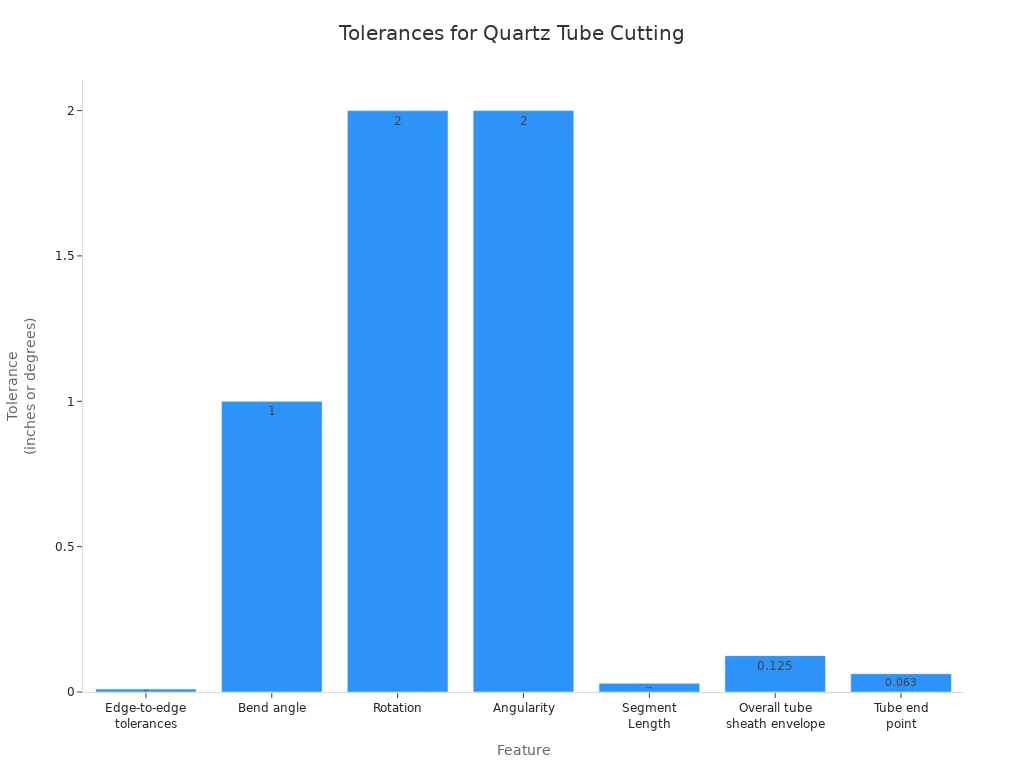
Önemli Noktalar:
Higher precision increases cost but boosts reliability
Critical applications benefit from tighter tolerances
Cost savings possible with relaxed requirements
By understanding these trade-offs, users can specify cutting requirements that align with both budget and performance goals.
Quartz tube cutting precision depends on several key factors.
Cutting method affects tolerance and edge quality.
Tube properties like wall thickness and diameter influence stability.
Proper fixturing and setup ensure accurate cuts.
Post-cut processing such as fire-polishing and cleaning improves final quality.
For best results, users should specify clear requirements, balance cost with needed precision, and always prioritize edge treatment. Open communication with manufacturers leads to better outcomes and longer-lasting quartz tubes.
SSS
What are signs your quartz tube needs cleaning?
Cloudy spots, reduced light transmission, or visible residue indicate cleaning is necessary. Technicians often notice performance drops in UV applications. Regular inspection helps identify these signs early and prevents long-term damage.
What are common mistakes that damage quartz tubes?
Using metal tools, applying excessive force, or skipping stress relief steps often causes cracks or chips. Technicians sometimes overlook proper fixturing, which increases breakage risk. Careful handling and correct setup prevent most damage.
What cutting method offers the best edge quality for optical applications?
Laser cutting with post-process polishing achieves the smoothest edges. Data shows edge roughness below 1 nm after polishing. This method supports high transmission rates and minimal light scattering, making it ideal for optical-grade tubes.
Tip: Always request edge quality data from the manufacturer before ordering tubes for optical use.
What is the recommended cleaning process for quartz tubes?
Technicians use a mild acid solution, rinse with water, and dry with a soft towel. For narrow tubes, gentle rinsing and air drying prevent scratches. Regular cleaning maintains clarity and supports long-term performance.
Adım | Açıklama | Etki |
|---|---|---|
Acid Wash | Removes contaminants | Restores clarity |
Water Rinse | Eliminates acid residue | Prevents corrosion |
Air Dry | Avoids scratches | Maintains surface |
What tolerance should be specified for furnace tube applications?
Most furnace tubes require ±0.5 mm length tolerance. Data from industry standards shows this meets fit and performance needs for 95% of cases. Tighter tolerances increase cost but rarely improve function for standard furnace use.



